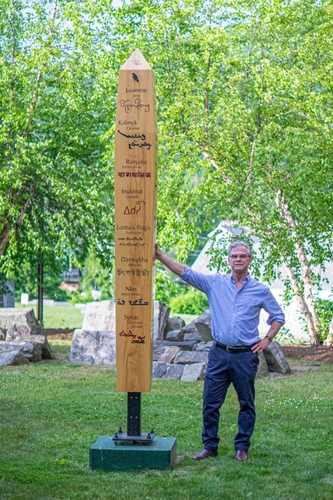BRATTLEBORO — On Wednesday, July 28, at 7:30 p.m., artist Scott Boyd joins Endangered Alphabets Project founder and author Tim Brookes for a free Zoom conversation presented by the Brattleboro Museum & Art Center (BMAC).
Boyd will speak about “Endangered Alphabets,” a 10-foot-high obelisk he created, on which he inscribed characters, symbols, and scripts drawn from the writing systems of endangered languages.
The obelisk is on view outside BMAC through November.
Boyd and Brookes will also discuss the project and its influence on the work of Boyd, who initially became interested in endangered alphabets when he attended a presentation by Brookes about the project.
The Endangered Alphabets Project is a Vermont-based nonprofit organization that supports endangered, minority, and indigenous cultures throughout the world by preserving their writing systems.
Brookes, the founder of the project, helped Boyd to research the endangered alphabets on the obelisk, which include Nüshu, Tifinagh, the Samaritan alphabet, and the Cherokee syllabary, among others.
He is the author of the book Endangered Alphabets: An Essay on Writing. His work has been covered in National Geographic, The Atlantic, and The New York Times.
“Due to shifting tides in politics, migration, armed conflict, and developmental pressures, many writing systems and languages are on the verge of disappearing,” Boyd said in a news release. “Some are spoken or written by as few as five people.”
Boyd, of Stowe, received his B.A. from Reed College and his M.F.A. in sculpture from the Yale University School of Art. He studied sculpture at the École des Beaux-Arts in Paris, France, and marble carving in Tinos, Greece and in Pietrasanta, Italy.
BMAC Chief Curator Mara Williams notes that the obelisk design dates back to the early Egyptians and has been used across cultures as a memorial object.
“In pairing this ancient form with near-extinct languages, Scott Boyd is doing more than memorializing; he is calling attention to the fragility of cultural diversity,” Williams said.
